 |
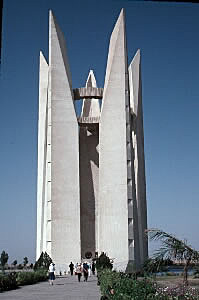 Monument at Aswan Dam 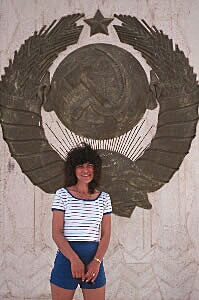 Anne standing under the Hammer and Sickle of the Soviet Union |
The building of the Aswan Dam is considered a modern marvel today. At the time it was built it was second only to the dam in Zambesi. It was built to control the raging waters of the life giving Nile. Construction on the dam began in January 1960 after years of negotiations with various countries Egypt entered into an agreement with the Soviet Union to allow them to build the dam. There were many problems encountered along the way. Russian equipment brought in for the job was designed for much colder climates and did not perform well in the scorching heat of the Egyptian Sun. Once completed the restrained waters of the Nile would form Lake Nasser, an artificial lake covering thousands of square miles. Its capacity would be 157 thousand million cubic meters of water. The impact on Egypt would be immense and, unfortunately, both good and bad. Before the dam was built only about 4% of Egypt's available land mass was under cultivation. It was envisioned that this would increase considerably by allowing the Egyptians to build an elaborate system of irrigation channels. The dam would also generate much needed electricity for the country. Damming the Nile it would eliminate the frequent inundation from flooding that occurred and allow for stored water to be provided during times of drought. But it would also dam the rich silt deposits that made Egypt's land so valuable and cultivable. Ever since the damming of the Nile Egyptian farmers have needed to use fertilizer for their crops. |
||||||||||
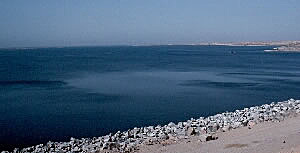 Lake Nasser |
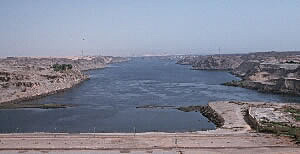 The Nile |
||||||||||
|
But, before the dam could be built a massive effort was required to save many historical artifacts that would have been covered by the waters of Lake Nasser. One of these sites was the Philae Temple. Philae is one of the best preserved Ptolemaic temples and sat on an island near the Nile. Philae is dedicated to the goddess Isis. After the construction of the old dam in 1904 the island was virtually covered by water for most of the year and only visited during August when the flood gates were opened. With the construction of the new dam the temple would have been completely covered by water. As a result a massive project was undertaken to move the temple, in its entirety, to another nearby island, Egelika, that would be safe from the waters of Lake Nasser. The temple was dismantled and moved stone by stone and then reassembled on Egelika. This was, needless to say, a gigantic undertaking and, again, much was learned about the building techniques of the ancient Egyptians. It was found that the tolerances for where stones must sit were measured in millimeters. It's amazing that the ancient Egyptians had such technology. |
|||||||||||
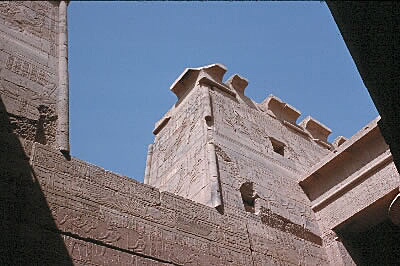 Philae Temple |
 Philae Temple column |
 Philae Temple columns |
|||||||||
|
Our time in Aswan was extremely limited. We left Luxor early in the morning and arrived, after stopping at Edfu and Kom Ombo, in Aswan in the middle of the afternoon. With no scheduled activities until the next morning Anne and I enjoyed ourselves by taking the ride aboard the felluca on the Nile. After that we enjoyed a relaxing evening at the hotel. The next morning we were off to visit the unfinished obelisk, the Aswan dam and Philae Temple. Having accomplished those goals we were deposited back at the hotel in the early afternoon, right in the middle of the hottest time of the day. The rest of the day we were free to do whatever we wanted, but with the oppressive heat the inclination was to stay inside. Everyone else on the tour group did just that. They stayed at the hotel and enjoyed the air conditioning or went swimming. Anne and I, wanting to savor as much of Aswan as we could, decided that we'd brave the extreme heat and venture down to the business district for some last minute shopping. This would be our last opportunity as we would board an overnight train to Cairo later that evening and, when we arrived in Cairo, head right back to the ship at Port Said. Shopping in Aswan was very interesting for the photographer in me. To see some of the pictures I took continue to the next page.
|
|||||||||||